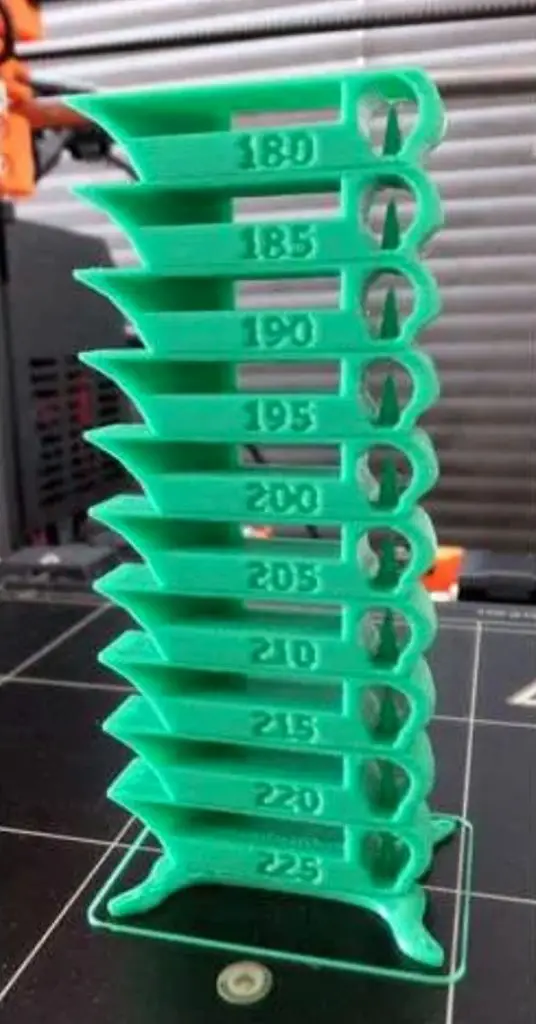One of the biggest challenges when printing with any filament is dialing in the correct printing and bed temperature. PLA filament is one of the most commonly and universally used 3D printing filaments out there, so what’s the ideal PLA printing temperature?
This is a question that commonly comes up for many first-timers to 3D printing, so let’s take a look.

What is the best nozzle temperature for 3D printing PLA
It would certainly make our 3D printing life much easier if PLA printed at one specific temperature that everyone around the world could just copy, but unfortunately, the answer is not that simple.
Instead, it’s useful to think of the best PLA printing temperature as a range of temperatures. For example, some types of PLA can print really well at around 190 degrees C, whereas others may require temperatures as high as 205 degrees C.
The best way to dial in your PLA printing temperature is to start at around 195 degrees C and then move up or down depending on the result.
Even a couple of degrees can make a difference, so make a note of what temperature you set and the results you got.
It’s important not to change any other variables when you do these tests! Make sure that the print speed, retraction, and bed temperature are the same across all of your prints.
What happens if the nozzle temperature is too low?
If your nozzle temperature is too low, you’ll run into a few issues that you can diagnose right away.
One issue is that your filament will not extrude at the consistency it should be extruding at.
Your layers will be brittle and wispy, and chances are the first layer won’t even stick to the bed. This is because the filament is not hot enough as it is being laid down.
If your nozzle temperature is way too low, then you risk clogging your nozzle, as the temperature will be high enough for the PLA to soften, but not high enough for it to flow through the nozzle at it should.
In this case you’ll probably hear your extruder clicking as it struggles to push the filament through.
One way to make sure your temperature is fine before starting the print is to manually push the filament through the hot end by disengaging the extruder. As you push, the filament should flow without excessive force. You’ll need to give a good push, but if you’re straining too much, the temperature is too low.
You can do this by manually raising the temperature of the nozzle by going into your 3D printer’s menu.
What happens if the nozzle temperature is too high?
If your nozzle temperature is too high as you print PLA, your prints will be messy and blobby as the filament is not cooling fast enough after it’s laid down.
If you find your prints droopy or saggy, or straight edges not coming out straight, your temperature is probably too high and you should knock it down a few degrees and try again.
Another issue you’ll run into is that your 3D printer will not be able to bridge properly. Bridging is where your printer lays filament across two separate areas of filament, connecting them, forming a “bridge”.
If your filament is too hot, the bridge will sag significantly as the plastic did not cool fast enough.
However, take this advice with a grain of salt – there’s only a certain distance an FDM printer can bridge, and that too if you’re using a cooling fan.
The best way to find your optimal bridging settings is to print a bridging torture test like this one.
Brands/colors make a difference
Interestingly enough, different brands of PLA will have different ideal printing temperatures. Even within one brand, you may find that one color prints at a different temperature than others.
My guess is that PLA manufacturing is not standardized to the letter, so there will always be a bit of variance.
While you may not really need a separate printing profile for different colors of PLA, you may certainly need separate profiles for different brands.
Once you’ve dialed in your PLA printing temperature for a particular brand of filament, try and stick to that brand for your future purchases.
You can find a list of the best PLA filaments here.
What is the best bed temperature for 3D printing PLA
The ideal bed temperature for PLA is much less complicated than the nozzle temperature. Generally, the consensus is using a heated bed at about 50 to 70 degrees C, though I’ve had no problems printing at 60 degrees C.
Heated beds are very common on most budget 3D printers too these days. If you happened to pick up a printer a few years ago, there’s a chance it does not have a heated bed.
The bed temperature helps your prints stick to the bed for the entirety of the print. If the temperature is off, the print can lift off the bed before it is complete. This is known as warping, and is very common in prints that have a large surface area on the bed.
If the bed temperature is too high, the excess temperature can cause the bottom layers to soften and squish under the weight of the rest of the print. This is known as elephants foot.
You may not really run into these issues unless you’re printing a really large object, so it may not be a problem for most prints.
Can you print PLA without a heated bed
In case your printer does not have a heated bed, you can use painter’s tape or a glue stick to help improve bed adhesion. Hair spray also works well.
You may be able to get away with smaller prints, but larger prints will be difficult to achieve.
Ideal ambient temperature for 3D printing PLA
One thing we haven’t discussed yet is the ambient temperature for printing PLA. Here’s where things get interesting. Your 3D printer’s nozzle can certainly maintain the temperature you set, and so can the bed, but if it’s too cold around the printer, the filament may prematurely cool before being laid down.
It’s like having a cooling fan on steroids!
You may find issues with layer adhesion if your printer is next to an open window or right under the draft of an air conditioner.
To really isolate the temperature variables, the ideal thing to do is build a 3D printer enclosure.
However, this may not be possible for everyone, so the next best thing is to keep your 3D printer in as close to room temperature as possible.
Printing a temperature tower
An easy way to find the ideal temperature range for a particular filament is to print a temperature calibration tower.
These models are designed to use a different temperature after every so many layers, so you can see the difference in the print as it progresses.
This particular model is really good because it also tests overhangs.
Conclusion
PLA is very easy to print and with just a little bit of experimentation, you should be able to find the ideal PLA printing temperature. Remember to be patient: 3D printing is a process!

